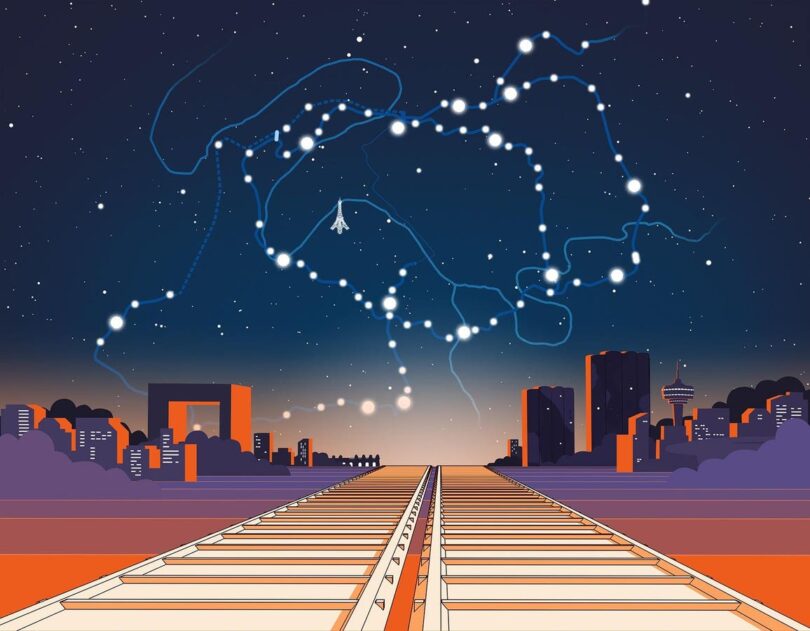The Grand Paris Express introduces 68 new stations and four new lines to the existing network.
Seven years ago, the largest civil engineering project in Europe broke ground in France. Now, it is finally taking shape. Here’s what it will mean for the City of Light.
Whether or not people realize it, the contours of greater Paris are being redrawn beneath their feet. In France, they’re calling it the “construction site of the century.” And that’s not a stretch.
The new Paris métro, formally titled Grand Paris Express (GPE), will more than double the territory encircling France’s capital city with over 120 miles of new tracks, four new underground lines and 68 new metro stations. The idea is to better connect distant Paris suburbs to the city and to each other—and in so doing, improve the commercial viability of its connected neighborhoods, business districts and municipalities.
By 2030, it is expected to transport at least 2 million passengers daily, shifting the entire Île de France region away from cars toward clean public transportation. There is undeniably a huge environmental cost for construction on this scale. But, once in operation, the project is expected to become a very powerful saver of carbon, which is in part why Harvard University awarded the Grand Paris Express the 2023 Veronica Rudge Green Prize in Urban Design, recognizing “design that transforms cities and the lives of its inhabitants in unanticipated and extraordinary ways.”
The Villejuif Institut Gustave-Roussy station is located in the Hautes-Bruyères park to the South of … [+]
Of course, this has been years in the making. Construction began in 2016, five years after then-President Nicholas Sarkozy called for its implementation in a national address extolling the virtues of the new metropolis: “We want to rebuild the city on top of the city, remove the divide between Paris and its suburbs, reduce the divides which separate the neighborhoods, which separate the inhabitants, we want to restore unity, continuity and solidarity.”
His vision has survived three presidential administrations, despite running years late and billions over-budget. Costs have since reached €36 billion ($39 billion), according to the Société du Grand Paris (Grand Paris Society), the state-owned infrastructure agency Sarkozy tasked with designing and implementing the project. Originally, it was meant to open in time for the Paris Summer Olympics in 2024.
Like other major transportation projects, delays seem inevitable. (We Manhattanites are still waiting for the completion of the multi-billion 2nd Avenue subway, an epic urban tale of only one line, not four.) But Paris is another story. The world-wide exposure that comes with hosting the Olympics has put significant pressure on the Grand Paris Society to deliver the goods. Of the 68 stations, 40 are already underway, and they’re hustling to unveil the first new station hub at Orly Airport by June 2024.
But First, A Museum Exhibit!
In classic French style, culture comes first. This November, to educate the public, the architecture museum at Trocadéro, Cité de l’architecture et du Patrimoine, has unveiled a new exhibition titled “Métro! Le Grand Paris en mouvement” running now through June 2, 2024.
It’s a breath of fresh futurism, taking space inside a monument to the past. The museum itself looks like something out of an Ayn Rand novel, a stone shrine glorifying centuries of French architecture, and with it the masterminds of the métropole. Grand Paris Express introduces new members into this elite club, heralding a new era of urban planning.
Co-commissioned by modernist architect Dominique Perrault and architectural critic Francis Rambert, the exhibition introduces visitors to the new map of ‘Greater Paris’ beyond its inner-city landscape, and invites them to reflect on the idea of a modern city and how its structure might engender new realities for its inhabitants. Consider it a future of cities master class in how a dense, spoken-for landscape becomes capable of moving 12 million people.
Architect Dominique Perrault in his Paris office.
Sitting in his firm’s glass-encased conference room in the 11th arrondissement, surrounded by models of districts yet-to-come, Perrault explained: “This infrastructure is very important because it changes the relationship between different parts of the metropole, connecting new railway stations with new districts. We are creating the double surface of Paris. The goal is to create a new skeleton, with the capacity and power to become a new structure for the metropole.”
Perrault Architecture has designed two integral sites for the Grand Paris network, one directly to the south of the city-center called Villejuif-Gustave Roussy station, as well as the Paris 2024 Athletes’ Village to the north, which will erect 2,400 housing units and supporting facilities that link directly to the Saint-Denis-Pleyel station designed by Kengo Kuma in the suburb where France’s Olympic stadium is located.
The Villejuif-Gustave station is under construction within Hautes-Bruyères park, connecting Line 14 directly to the entrance of Europe’s leading oncology hospital, the Gustave-Roussy Institute. Anticipated in 2025, the station’s opening will mark a major milestone, in that it introduces a wildly ambitious take on underground architecture — it runs about 164 feet deep — creating a massive, multi-level cylinder of open-air space bathed in natural light, by using a novel system of light boxes to illuminate space where there was only darkness.
A view from below. Villejuif-Gustave Roussy station in France.
It is a passion project for Perrault, who has set out to prove the viability of one of the deepest transportation infrastructures in France. “The ground and the territory below it, with its geography and its landscapes, offers the promise of extraordinary potential, and a possible response to the seemingly unsolvable questions raised by urban density,” writes Perrault in “Groundscapes” (2016), a book exploring the potential and possibility of subterranean architecture.
The Villejuif-Gustave station will also feature its own custom artwork, created by Chilean artist Ivan Navarro, who works with light and optical illusions. It is titled “Cadran Solaire,” resembling a starry sky made up of 60 illuminated boxes integrated into the ceilings at the exit of the platforms. Each of these boxes bears the name of a celestial body, playing on the concept of passage and giving the illusion of depth.
It’s a fantastic combination of art and architecture that is planned similarly for each and every one of the 68 stations, which must also technically coordinate with the existing SNCF Réseau commuter rail and RATP metro networks. But the ambition doesn’t stop there.
Form Meets Function
Early on, the Grand Paris Society decided to allocate a portion of its budget, roughly 35 million euros, to commission contemporary art for each station — creating a vast, connected gallery, made available to everyone with a subway ticket.
In practice, that means select teams of architects, engineers and artists are now working together not just to connect trains — but to reimagine metro stations as culturally relevant, public spaces. “In the 19th century, we had Hector Guillmard who designed the iconic art nouveau entrances of the Paris métro for all the stations. For GPE, we want to have a unique architecture for each urban context, because each community is very different. Our co-design program creates a real dialogue for each station,” said Pierre-Emmanuel Becherand, head of architecture, design and culture at Société du Grand Paris.
The station at Orly Airport, for example, tapped Portuguese artist Alexandre Farto, a.k.a. VHILS to work with French architect François Tamisier and design a monumental mural for the new space. Spanning 16 meters long and 12 meters high, it comprises 11,000 individual pieces of azulejos (traditional Portuguese ceramic tiles) depicting inhabitants’ faces blended into the fabric of the city as if each forms the identity of the other.
A mural of 11,000 porcelain tiles at Orly Airport, by artist Vhils.
The Politics Of Progress
Who benefits is a going concern. Perrault is the first to admit the project is “totally political.” Because it will directly serve specific constituents with low-cost transportation. With the same ticket, passengers will be able to take the new métro, change to a bus, then hop on a train to get where they need to go. It practically eliminates the need for a car, which has clear socio-economic and environmental benefits. So, who decides which neighborhoods to serve? And which firms land the contracts?
“The process is complex; the money comes from the state. And the state is more or less the architect of policy. On the other hand, you have two actors; one actor is the city of Paris, and then you have the regions. Mayors might have opinions about outcomes. But ultimately, it’s the state,” he adds, candidly. That tracks. Each person serving on Société du Grand Paris’s Management Board was appointed by decree of the French president. Now, the public is demanding answers.
There have been significant delays and setbacks since the project was conceived, and now even the taxi drivers in Paris roll their eyes at mere mention of the subject. What’s worse, there have been five fatal accidents that occurred on Grand Paris Express construction sites. These accidents undermine the Société du Grand Paris, which had ensured worker safety was a priority.
Not all inner-city residents are happy about the project. Many fear increased violence and destruction by “les casseurs” (thugs) of hallowed ground will come with easy access into Paris. At Orly airport this month, a local retired couple declined to be named yet immediately blamed Macron for the project. “He’s letting everyone in. They don’t work, and live off our social support. Get out.”
Despite the naysayers, mobility and sustainability are the macro themes that will come to define the future of cities. As host of the 2024 Olympics, the city has no choice but to expand and modernize. And it will be richly economically rewarded for doing so. The new metro is like a tree; from its strong base, an extraordinary system of branches can grow. It will help develop new connections, foster investment, and allow for the circulation of both people and ideas.
For a city so exquisitely shaped by the past, Paris has found a way to shape its future.








